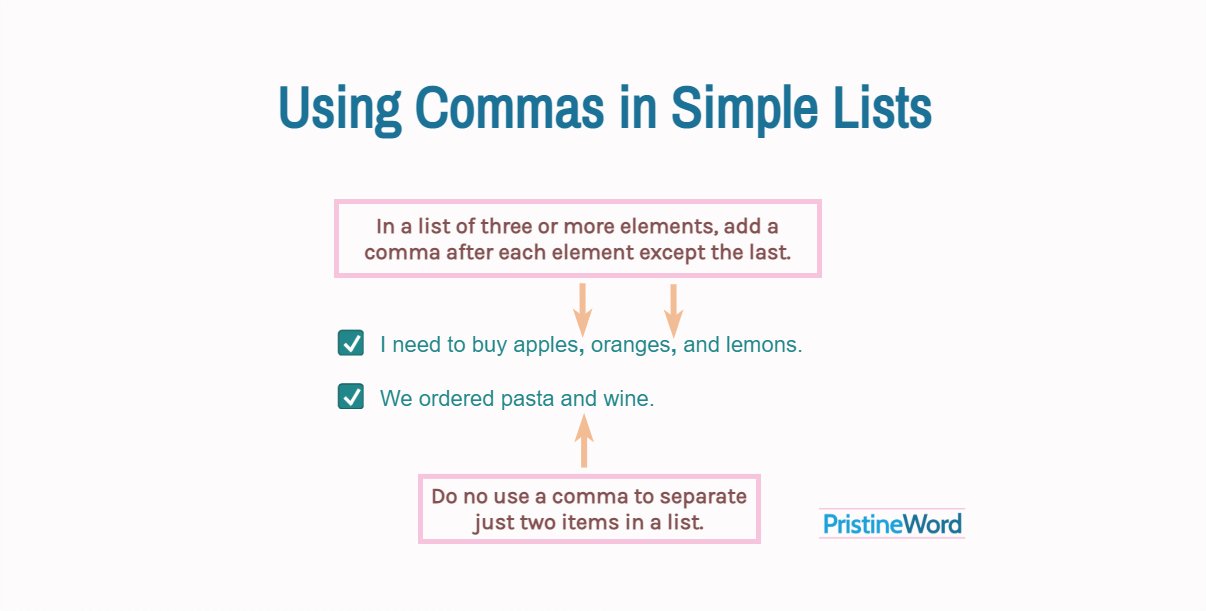In a list of three or more elements, add a comma after each element except the last.
In a list of three or more elements, add a comma after each element except the last.
I need to buy apples, oranges, and lemons.
Last year, the countries with the highest life expectancy included Japan, Switzerland, Singapore, and Spain.
Contents
1. Basic Rule
Use commas to separate words and word groups in a simple list of three or more terms.
My girlfriend is creative, charming, cute, and bright.
Do not use a comma to separate just two items in a list.
We ordered pasta and wine.
We ordered pasta, and wine.
More examples
- The colors of the French flag symbolizes nobility (blue), clergy (white), and bourgeois (red).
- Willpower, integrity, passion, connection, and optimism are the top qualities of highly successful people.
- I don't understand why gold prices jumped, interest rates fell, and stock prices collapsed last summer.
- Russia, Canada, USA, China, and Brazil are the five largest countries in the world by total area.
- My boss is arrogant, impolite, narrow-minded, and dogmatic.
Recommended: How to Use Commas in Bulleted and Numbered Lists
2. The Oxford Comma (or Serial Comma)
The comma before and/or when using a list of three or more elements is known as the Oxford comma or the serial comma.
The Oxford comma is optional, so you can decide whether to use it or leave it out.
In July, we went on a trip to Thailand, Vietnam and Indonesia.
It is important, however, to be consistent and avoid switching back and forth, except when omitting the Oxford comma could cause confusion or misunderstanding. For example:
I went to the party with my sisters, Mary and Patricia.
Without further contextual information, it is unclear whether my sisters are Mary and Patricia; however, using a comma in front of "and" makes it clear that I went to the party not only with my sisters, but also with Mary and Patricia.
I went to the party with my sisters, Mary, and Patricia.
In a situation like this, clarity demands the Oxford comma.
While some writers prefer to use the Oxford comma, others tend to omit it:
❝ Most newspapers and magazines drop the Oxford comma in a simple series, apparently feeling it's unnecessary...Fiction and nonfiction books generally prefer the Oxford comma. ❞
Kaufman, Lester; Straus, Jane. The Blue Book of Grammar and Punctuation.(1)
As for using a company's name or a proper noun, follow the conventional usage.
Miller, Wilson & Company
Recommended: Comma after "first", "second", etc.
3. Using 'For example', 'e.g.', or 'Such as' to Introduce a List
Use a comma after "e.g.", "for example", "for instance", and similar terms to introduce a list (series of examples).
Some European cities, e.g., Helsinki, Oslo, and Moscow, are extremely cold in winter.
Note that we add commas not only after each item but also:
- before the introductory term (before "e.g." in the example above), and
- at the end of the list (after Moscow in the example above).
Instead of using commas, you can set off the whole expression with parentheses or em-dashes.
Some European cities (e.g., Helsinki, Oslo, and Moscow) are extremely cold in winter.
If the list comes at the end of the sentence, the period replaces a comma.
I like many extreme sports, e.g., snowboarding, diving, or mountain biking.
When using "such as" to introduce a list of terms, do not place a comma before "such as" if the list is essential to understand the meaning of the sentence; that is, if it defines or limits.
Sports such as soccer, basketball, and hockey are my favorite.
4. Ending a List with the abbreviation 'etc.'
When using a series of terms in mid-sentence, enclose the abbreviation "etc." between commas.
Many commodity assets, oil, gold, silver, etc., are extremely volatile.
As mentioned in the previous section, other punctuation marks (parentheses, em-dashes, periods, etc.) replace commas.
Many commodity assets (oil, gold, silver, etc.) are extremely volatile.
Avoid using the abbreviation "etc." at the end of a list introduced by "e.g.", "for example", "such as", or any similar expression.
Healthy exercise (for example, stair climbing, cycling, running, etc.) will help you lose weight.
The sentence above is incorrect because the term "for example" implies that other examples are being omitted.
Healthy exercise (for example, stair climbing, cycling, running) will help you lose weight.
5. References
(1) Kaufman, Lester; Straus, Jane. The Blue Book of Grammar and Punctuation. Chapter 2 (punctuation).

